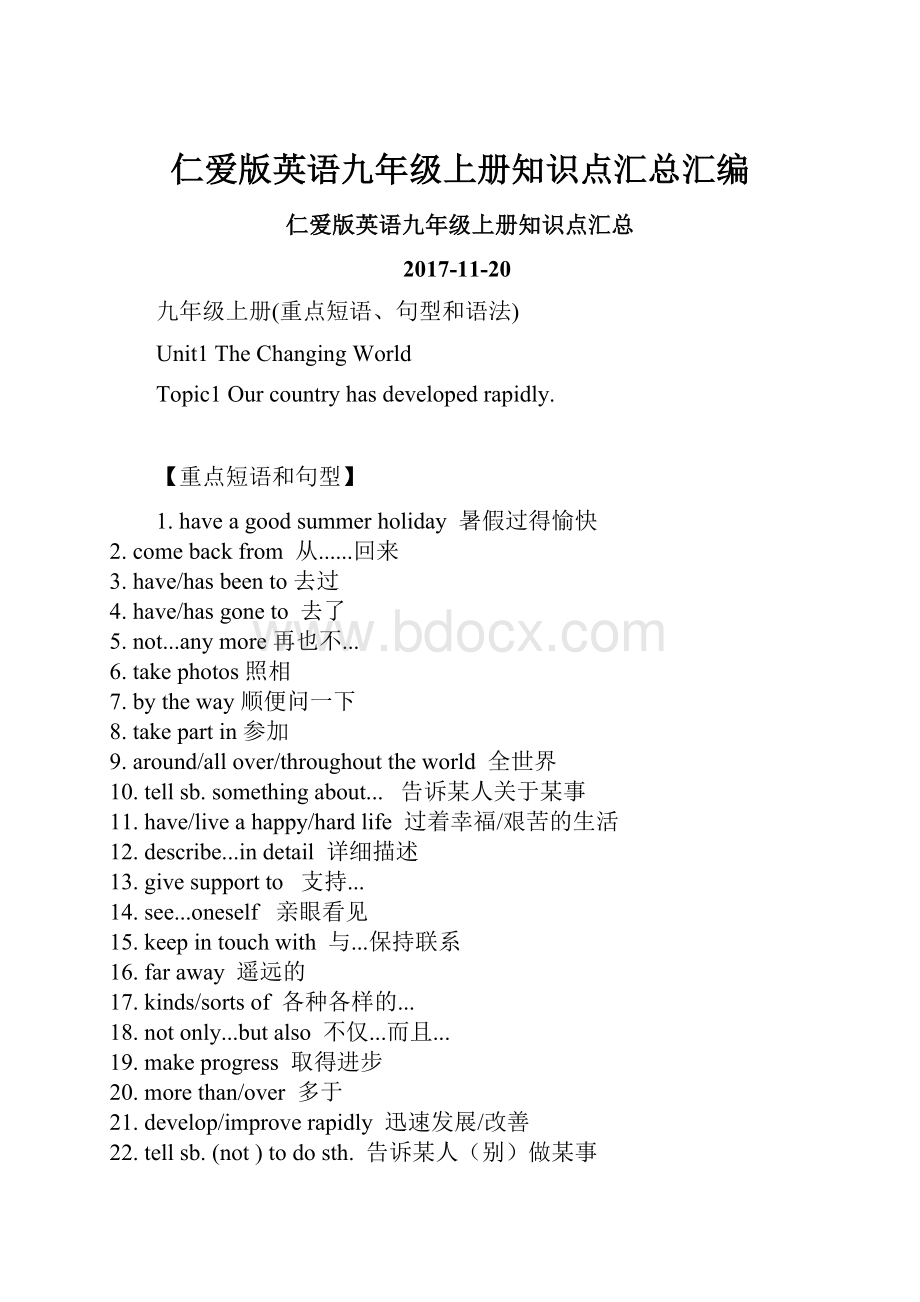 仁爱版英语九年级上册知识点汇总汇编.docx
仁爱版英语九年级上册知识点汇总汇编.docx
- 文档编号:9146688
- 上传时间:2023-02-03
- 格式:DOCX
- 页数:23
- 大小:30.92KB
仁爱版英语九年级上册知识点汇总汇编.docx
《仁爱版英语九年级上册知识点汇总汇编.docx》由会员分享,可在线阅读,更多相关《仁爱版英语九年级上册知识点汇总汇编.docx(23页珍藏版)》请在冰豆网上搜索。

仁爱版英语九年级上册知识点汇总汇编
仁爱版英语九年级上册知识点汇总
2017-11-20
九年级上册(重点短语、句型和语法)
Unit1TheChangingWorld
Topic1Ourcountryhasdevelopedrapidly.
【重点短语和句型】
1. haveagoodsummerholiday 暑假过得愉快
2. comebackfrom 从......回来
3. have/hasbeento 去过
4. have/hasgoneto 去了
5. not...anymore 再也不...
6. takephotos 照相
7. bytheway 顺便问一下
8. takepartin 参加
9. around/allover/throughouttheworld 全世界
10. tellsb.somethingabout... 告诉某人关于某事
11. have/liveahappy/hardlife 过着幸福/艰苦的生活
12. describe...indetail 详细描述
13. givesupportto 支持...
14. see...oneself 亲眼看见
15. keepintouchwith 与...保持联系
16. faraway 遥远的
17. kinds/sortsof 各种各样的...
18. notonly...butalso 不仅...而且...
19. makeprogress 取得进步
20. morethan/over 多于
21. develop/improverapidly 迅速发展/改善
22. tellsb.(not)todosth. 告诉某人(别)做某事
23. asksb.(not)todosth. 要求某人(别)做某事
24. inordertodosth. 为了做某事
25. havetodosth. 不得不做某事
26. It's+形容词+forsb.todosth. 对于某人来说做某事是...的
27. whynotdosth.=whydon’tyoudosth 为什么不做某事
28. succeed/besuccessfulindoingsth.成功地做某事
29. dreamaboutdoingsth. 梦想做某事
30. see/hearsb.do/doingsth. 看见/听见某人做/正在做某事
【重点语法】
现在完成时
一.现在完成时的基本结构
肯定句:
主语+have/has+Ved(动词的过去分词)+其他
否定句:
主语+have/has+not+Ved(动词的过去分词)+其他
一般疑问句:
Have/Has+主语+Ved(动词的过去分词)+其他
特殊疑问句:
特殊疑问词+一般疑问句语序(have/has+主语+过去分词+其他),把划线词去掉
二.现在完成时的用法
1.现在完成时用来表示过去已经完成的动作对现在造成影响或后果。
也就是说,动作或状态发生在过去但它的影响现在还存在,强调的是现在。
I havealreadypostedthephoto.
我已经邮寄出了照片。
现在完成时常用的时间状语,如already(肯定句句中),yet(否定句/疑问句句尾),just,before,recently,still,lately,never等。
2. 现在完成时也可用来表示动作或状态发生在过去某一时刻,持续到现在并且有可能会继续持续下去。
Hehaslivedheresince1978.
自从1978年以来,他一直住在这儿。
(动作起始于1978年,一直住到现在,可能还要继续住下去。
)
此种用法常与for(+时间段,since(+时间点或过去时的句子)连用。
谓语动词必须是延续性动词。
有些瞬间动词可变为延续动词:
goout----beout
finish----beover
open----beopen
die----bedead
buy---have
fallill---beill
comeback----beback
catchacold----haveacold
Topic2Thepopulationindevelopingcountriesisgrowingfaster.
【重点短语和句型】
1. getlost 迷路
2. acoupleof 一些,几个
3. withthedevelopmentof 随着...的发展
4. withthehelpof... 在...的帮助下
5. oneofthe+形容词最高级+名词复数 其中之一/最...的其中之一
6. eachother 互相
7. call/ringsb.up 给某人打电话
8. atleast 至少
9. sth.happentosb. 某人发生某事
10. Whathappenedtosb?
某人发生某事?
11. takeplace 发生
12. becauseof 因为,由于
13. bestrictwithsb./insth. 对某人/某事严格要求
14. carryout 执行
15. thousands/millions/hundredsof 成千上万/无数的/成百上千...
16. twothousand/million/hundred 两千/百万/百(具体数字后面不加s)
17. halfof... 一半...
18. twothirds 三分之二
19. beshortof 短缺...
20. sofar 到目前为止
21. beknown/famousfor 因...而闻名
22. beknown/famousas 作为...而闻名
23. thanksto 幸亏...
24. havealongwaytogo 有很长的路要走
25. atowncalled... 一个叫做...的镇
26. fewerthan/lessthan 少于
27. placesofinterest 名胜古迹
28. beinterestedin 对...感兴趣
29. suchas 例如...
30. look/smell/sound/feel/taste+形容词 看/闻/听/摸/尝起来...
31.sucha/an+形容词+sb./sth 如此...的人/物
32. takesb.tosp 带某人去某地
33. keepupwith 赶上
34. havefundoingsth. 做某事很愉快
35. haveapopulationof... 有...的人口
36. What'sthepopulationof...?
...有多少人口?
37. wanttodosth. 想要做某事
38. hatetodosth 讨厌做某事
39. takemeasurestodosth. 采取措施做某事
40. have(no)chance/timetodosth. 有机会/时间做某事
41. usedtodosth. 过去常常做某事
42. beusedtodosth. 被用来做某事
43. be/getusedtodoingsth. 习惯做某事
44. workwellindoingsth. 在...方面起到显著作用
【重点语法】
常用于现在完成时的时间状语:
already,just,yet,ever,never,recently.
e.g.
1.Ihavejust calledyou.
2.——Haveyouever beentoFrance?
——No,I’venever beentoanyEuropeancountries.
3.——Haveyouseenhimyet?
——Yes,Ihaveseenhimalready.
Topic3Theworldhaschangedforthebetter.
【重点短语】
1. withthemoney 用这些钱
2. sothat 为了,以致于
3. so...that... 如此...以致于...
4. infact/asamatteroffact 事实上
5. comeforavisit 来参观
6. inneed 在困难时
7. decideonsth. 决定某事
8. providesth.forsb./providesb.withsth. 为某人提供某物
9. feelgoodabout... 对...有信心
10 lendsth.tosb/lendsb.sth. 把某物借给某人
11. borrowsth.fromsb. 向某人借某物
12. atthesametime 与此同时
13. talkonthephone 在电话中交谈
14. takedrugs 吸毒
15. payfor 付款
16. buysth.forsb. 给某人买某物
17. athomeandabroad 在国内外
18. sendsb.tosp. 送某人去某地
19. sendforsb. 派人去请某人
20. aimtodosth. 目的是做某事
21. decide(not)todosth. 决定(不)做某事
22. finishdoing 结束做某事
23. Howdoyoulike.../Whatdoyouthinkof...?
你觉得...怎么样?
24. sb.spendst.indoingsth=Ittakessb.st.todosth. 某人花费...时间做某事
25. sb.spendsomemoneyonsth.=sb.paysomemoneyforsth. 某人花费...钱买某物
26. so+be/助动词/情态动词+主语 表示后者情况与前者一样(表肯定)
neither/nor+be/助动词/情态动词+主语 表示后者情况与前者一样(表否定)
27. so+主语+/be/助动词/情态动词 表示的确如此
【重点语法】
1.现在完成时:
常与for或since引导的时间状语连用,表示从过去某一时刻延续到现在。
e.g.YouhavebeeninNewYorkforalongtime.
ThecityhasimprovedalotsinceIcamehereafewyearsago.
2.构词法:
合成词:
home+work=homework
派生词:
use——useful,happy——unhappy
Unit2SavingtheEarth
Topic1 Population causestoomanyproblems.
【重点短语】
1.chemicalfactory 化工厂
2.pour…into… 把……排放到……
3.inabadmood 处在不好的情绪中
4.managetodosth. 设法去做某事
5.doharmto… / beharmfulto… 对……有害
6.quiteafew 相当多
7.nobetterthan 同…….一样差
8.inpubic 公开地
9.allsortsof 各种各样的
10.inmanyways在许多方面
【重点句型】
1.Look,thereareseveralchemicalfactoriespouringwastewaterintothestreams.
看,有几家化工厂正往河里排放废水。
2.Everythinghaschanged.一切已发生了变化。
3.Howlonghaveyoubeenlikethis?
你像这样多长时间了?
4.I’malwaysinabadmoodbecauseIcan’tstandtheenvironmenthere.
我的情绪总是很差因为我受不了这里的环境。
5.However,notallpeopleknowthatnoiseisalsoakindofpollutionandisharmfultohumans’health.
然而,并非所有的人都知道噪音也是一种污染,而且有害于人类健康。
【重点语法】
直接引语和间接引语
1.Grannysaid,“I’mfeelingevenworse.”
Grannysaidthatshewasfeelingevenworse.
2.“Doyoustillwanttolivehere,Granny?
”thejournalistasked.
ThejournalistaskedGrannyifshestillwantedtolivethere.
3.“Howistheenvironmentaroundthisplace?
”thejournalistasked.
Thejournalistaskedhowtheenvironmentaroundthatplacewas.
Topic2All theseproblemsareveryserious.
【重点短语】
1.asaresult 结果
2.hereandthere 到处
3.inthebeginning一开始
4.indanger处于危险中
5.cutdown 砍倒
6.changesth.intosth. 把……变成……
7.preventfrom 防止
8.greenhouseeffect 温室效应
9.referto 提到
10.dealwith处理
12.cutoff 中断
【重点句型】
1.Asweknow,noneofuslikespollution.众所周知,没有人喜欢污染。
2.Humanshavecometorealizetheimportantofprotectinganimals.人类逐渐意识到保护动物的重要性。
3.Treescanalsostopthewindblowingtheearthaway.树木也能防风固土。
4.Cuttingdowntreesisharmfultohumanbeings,animalsandplants.砍伐树木对人类、动植物都有害。
5.Somethingswe’vedoneareverygoodforearthwhilesomearenotgood. 我们所做的,有些对地球很好,而有些不利。
6.Theycanalsopreventthewaterfromwashingtheearthaway.它们也能阻止水土流失。
7.Whenitrainsorwhenthewindblows,theearthistakenaway.天一下雨或刮风,土就会被冲走或刮走。
【重点语法】
不定代词
1.定义:
指的是那些不指明代替任何特定名词或形容词的代词。
2.用法:
在句中可作主语、宾语、表语、定语等。
something,somebody,anything,anybody等作主语时,通常视为单数。
当形容词修饰它们时,要放在其后。
e.g.Butthegovernmenthasdonesomethinguseful toprotecttheenvironment.
Topic3 What kindsofthingscanwedotoprotecttheenvironment?
【重点短语】
1.notonly…butalso… 不仅……而且……
2.besupposedto应该
3.oughtto应该
4.turnoff 关掉
5.insteadof 代替
6.ontime 准时
7.makesure确保
8.pushforward向前推
9.pushdown 向下
10.pullup 向上拉
【重点句型】
1.Forexample,weshouldusebothsidesofpaperandreuseplasticbags.
例如,我们应该用纸的两面,并且重新使用塑料袋。
2.Everyoneissupposedtodothat.每个人都有义务那样做。
3.First,yououghttoturnoffthelightswhenyouleavearoom.首先,你离开房间时应该随手关灯。
4.Easiersaidthandone.说起来容易做起来难。
5.Well,actionsspeaklouderthanwords.嗯,百说不如一做。
6.Therewillbealotofhardworktodotomorrow,somakesureyougotobedearlytonight.
明天有许多繁重的活要干,今晚一定要早睡。
【重点语法】
并列句:
由两个或两个以上并列而又相互独立的简单句构成。
结构为:
简单句+并列连词+简单句
常用的并列连词有:
and,or,but,while,notonly…butalso...
e.g.1.Theriverisdirtyandthetemperatureoftheearthisrising.
2.Theyworkwell,buttheyareslowandcan’trunforlong.
Unit3 EnglishAroundtheWorld
Topic1 English iswidelyspokenthroughouttheworld.
【重点词语】
1.beableto=can 能够,会
2.can’twaittodosth.迫不急待地做某事
3.havea(good)chancetodosth.有(好)机会做某事
4.practicedoingsth.练习做某事
5.bemadeby…被……制做
bemadeof/from…由……制成
bemadein…在某地制造
6.onbusiness出差
7.besimilarto…和……相似
8.translate…into…把……翻译成……
9.haveno/sometrouble(in)doingsth.做某事没有/有些困难
10.onceinawhile=sometimes/attimes偶尔,间或
11.whenever=nomatterwhen无论何时
12.aswellas以及
13.mothertongue母语
14.taketheleadingposition处于领先地位
15.encouragesb.todosth.鼓励某人做某事
16.callfor号召
【重点句型】
1.Disneylandisenjoyedby millionsofpeoplefromallovertheworld.世界上数以百万的人们都喜欢迪斯尼乐园。
2.IhopeIcangothereoneday.希望有一天我能去那儿。
3.English is widelyspoken aroundtheworld.英语在世界上被广泛使用。
4.It isalsospokenasasecondlanguage inmanycountries. 在许多国家它也被用作第二语言。
5.Itispossiblethat youwillhavesometrouble.你可能会遇到一些麻烦。
6.It’susedasthefirstlanguagebymostpeopleinAmerica,Canada,Australia,GreatBritainandNewZealand. 它被美国、加拿大、澳大利亚、英国和新西兰的大多数人用作第一语言。
7.And twothirds oftheworld’sscientistsreadEnglish. 并且世界上三分之二的科学家用英语阅读。
【重点语法】
一般现在时的被动语态
英语语态有主动语态和被动语态两种。
主语是动作的执行者,叫主动语态。
如:
Wecleantheclassroom.我们打扫教室。
主语是动作的承受者,叫被动语态。
如:
Theclassroomiscleaned(byus).教室被(我们)打扫。
1. 被动语态的构成:
助动词be+及物动词的过去分词+(by+宾语)
其中by意为“被……;由……”,表动作的执行者。
如:
Theglassisbrokenbythatboy.玻璃杯是那个男孩打破的。
be有人称、数和时态的变化,其肯定式、否定式、疑问式的变化规则与be作为连系动词时完全一样。
如:
Englishis widely spokenaroundtheworld.(肯定式)
English isnotwidelyspoken aroundtheworld.(否定式)
---Is Englishwidely spokenaroundtheworld?
(疑问式)
---Yes,itis./No,itisn’t.
2.被动语态的用法:
(1)在没有指明动作的执行者或者不知道动作执行者的情况下可用被动语态。
如:
Thiscoatismadeofcotton.这件大衣是棉制的。
(2)要
- 配套讲稿:
如PPT文件的首页显示word图标,表示该PPT已包含配套word讲稿。双击word图标可打开word文档。
- 特殊限制:
部分文档作品中含有的国旗、国徽等图片,仅作为作品整体效果示例展示,禁止商用。设计者仅对作品中独创性部分享有著作权。
- 关 键 词:
- 仁爱 英语 九年级 上册 知识点 汇总 汇编
 冰豆网所有资源均是用户自行上传分享,仅供网友学习交流,未经上传用户书面授权,请勿作他用。
冰豆网所有资源均是用户自行上传分享,仅供网友学习交流,未经上传用户书面授权,请勿作他用。


 《Java程序设计》考试大纲及样题试行.docx
《Java程序设计》考试大纲及样题试行.docx
